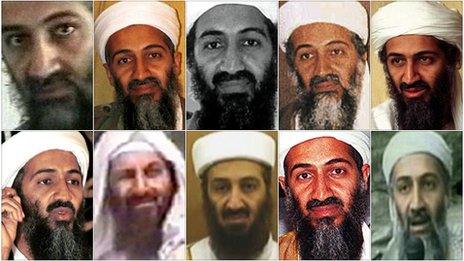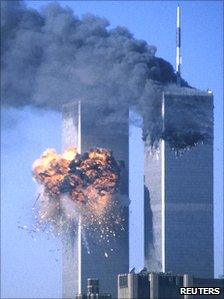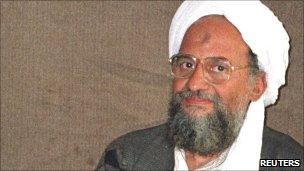Viewpoint: What is Osama Bin Laden's place in history?
- Published
- comments

The death of Osama Bin Laden has dominated headlines across the world, but how will history remember him? Historian Michael Burleigh gives his view.
For several years people have speculated that Osama Bin Laden was dead, whether from a chronic kidney ailment, or blown to pieces in his Tora Bora redoubt in late 2001 as the US responded to 9/11.
The mystery was solved when a US special forces operative shot a startled Bin Laden in the forehead during a raid on his Abbottabad residential compound. In order to pre-empt any grave becoming an Islamist shrine, Bin Laden's corpse was buried at sea.
This act highlights the importance of myths and symbols in any war. For it has long been argued that whether alive or dead, Bin Laden would become the mythic poster boy of global militant Islam, rather as the Cuban revolutionary Che Guevara was for the international juvenile left, long after the CIA and its Bolivian government associates killed him in 1967.
Since 9/11 Bin Laden has been of symbolic, rather than operational, significance to al-Qaeda. Although he has communicated via couriers, like those the US used to trace him back to Abbottabad, in reality, day-to-day operational control would require the internet and satellite telephones, all of which would have invited a Predator drone strike within minutes.
Although Bin Laden's deputy, the Egyptian surgeon Ayman al-Zawahiri, lives to fight another day, this ageing and portly figure is deeply uncharismatic, and besides, his principal fixation with toppling the Mubarak regime in his homeland is severely out of date since the events of the Arab Spring.
There have always been those who think it is "good to talk" to terrorists, a view which echoes the 1930s policy of appeasing the European dictators. The killing of Bin Laden has comprehensively demolished the extraordinary claims of people like Tony Blair's former chief of staff, Jonathan Powell, that the al-Qaeda leader should be negotiated with, or Eliza Manningham-Buller, the former MI5 chief, that approaches could be made to those on "the periphery" of al-Qaeda.
One man would like to slip into Bin Laden's vacant shoes - the US-Yemeni terrorist Anwar al-Awlaki, who inspired the underpants bomber - but whether he lives long enough to assume such a role must be moot given recent events and the sheer implacability with which President Obama is going after America's enemies.
Awlaki also lacks the specific combination of characteristics that enabled Bin Laden to become such a potent figure. For his own life is like a parody of a riches-to-rags fairytale. Bin Laden's construction billionaire father had migrated to Saudi Arabia as a child in the 1920s from Yemen's harsh Hisdradut region.

The attacks on the World Trade Center will not be forgotten
But his son turned to the most extreme and puritanical forms of Islam in his late teens, partly at the feet of exiled Palestinian and Syrian religious instructors under the influence of the Muslim Brotherhood. Their ideologues had already turned the faith into an ideological weapon, claiming that all other Muslims were benighted, deluded or heretical.
A fortune estimated at between $35m and $250m meant that Bin Laden could turn his most extravagant fantasies into reality.
Directing a polyglot immigrant labour force for the family business gave Bin Laden experiences which he put to effective use in running a multinational terrorist organisation. While its vision is deeply retrogressive, al-Qaeda utilised the most modern technologies, and had such things as job descriptions, application forms, and paid holidays for its members.
This should not disguise the fact that they took semi-feudal oaths of loyalty to the man who called himself "the Sheikh". In the early 1980s a "charity" facilitating Arab war tourists developed into a 2,000-strong jihadist force helping the Afghans fighting the Soviets.
In these years Bin Laden indulged in the extreme romanticisation of himself, a common pathology among all of history's terrorists. Credulous Afghans marvelled at this obviously rich Saudi who chose life in scorpion-infested caves, where his diet was a simple vegetable stew and water. Bin Laden claimed that victory was his and moreover that defeat in Afghanistan had collapsed the entire Soviet system.
Bin Laden was convinced that the consumerist and hedonistic Americans were a weaker proposition than the Soviets, and that he could bring down the US too. This hubristic delusion would ultimately bring about his own demise.
Bin Laden's parallel denunciations of the Saudi ruling dynasty for inviting Western forces into Saudi Arabia to ward off the predations of Saddam Hussein, while rejecting the assistance of Bin Laden's own jihadist international brigade, meant that in 1991 he was expelled and in 1994 denationalised, though Saudi money continued to find its way to al-Qaeda so long as Bin Laden did not strike within the kingdom itself.
He fled first to Sudan, where his money talked in such a poor country, and then in 1996 back to Afghanistan, where he resolved to strike at western interests which, he and Zawahiri, felt were propping up autocratic regimes throughout the Middle East.
This was the true beginning of the simple narrative myth of a defensive jihad against "Crusader-Zionist" aggression against the universal Muslim ummah. And so it might seem if one's vision was restricted to a few lurid TV images from Bosnia or Chechnya as refurbished by al-Qaeda's own media outlets. For al-Qaeda's "truths" relied upon huge distortions and massive ignorance of the world on the part of his sympathisers.
In reality, Bin Laden himself was the source of aggression, with Bin Laden calling for jihadists to kill American civilians wherever they could. A series of ever bolder terrorist strikes ensued.
Each of these attacks was long in the making, relying on tight cells of terrorists all of whom had received some form of training at al-Qaeda's camps in Afghanistan or who were in some way directed by al-Qaeda.
Bin Laden's own role was to green light projects which others presented him with - for example the mastermind behind the 9/11 attacks was Khalid Sheikh Mohammed.

Ayman al-Zawahiri is not seen as having the charisma of Bin Laden
Somewhat later, ideologically cognate groups would simply claim they had acted under al-Qaeda's general inspiration. It suited Bin Laden to claim authorship of attacks he probably had little responsibility for since it magnified his global influence.
By the time of 9/11, Bin Laden's terrorist organisation had effectively captured a state. Afghanistan bore the brunt of the US armed response to 9/11.
Although Bin Laden prided himself on his strategic genius, and did undoubtedly succeed in inspiring many angry young Muslims to heed him, in reality the US deposition of the Afghan Taliban government was a disaster for him and his organisation, forcing them to rely on affiliated actors whose priorities were often more local than al-Qaeda's.
Over the past nine years, core al-Qaeda has been progressively marginalised - to the point where it did not overly matter if Bin Laden was captured or killed - while relentless warfare has inclined sections of the Taliban to find an accommodation with the Kabul government.
Bin Laden's death is likely to accelerate that process. But his longer term legacy is more imponderable.
For sure, Bin Laden will be regarded by future historians as one of the major symbolic villains in modern history. Purely in terms of death tolls he is not in the same class of genocidal killer as Saddam Hussein, let alone Hitler, Stalin or Mao.
Of course, in some quarters Mao remains a poster boy for a certain type of revolutionary implacability. But no-one is likely to forget the 3,000 people murdered on 9/11 any time soon, a massacre which puts most terrorist actions in the shade, achieving in a single day the entire death toll in Northern Ireland over a 30-year period. His terrorist career clearly eclipses that of most earlier terrorists, whose victims number in single digits or low hundreds.
More important is the question whether in a few years Bin Laden sinks into relative obscurity among young Muslims around the world - apparently his visage disappeared from T-shirts in Pakistan and Palestine long ago.
Apart from easily excitable Islamist mobs in Pakistan, only the extreme Islamist Palestinian faction Hamas seems to be lamenting his demise. Of course, whether Bin Laden remains relatively marginal depends largely on whether secular reform movements in the Middle East can deliver more than the angry violence represented by militant Islamists.
In that eventuality, Bin Laden as myth could undergo constant revival, just as Che Guevara seems to excite the imaginations of people not yet born in the 1960s. One should never underestimate some people's susceptibility to such romantic myths.
Since Bin Laden was entirely marginal to the revolts that have been dubbed the Arab Spring, for the moment his myth seems to be on the wane. Al-Qaeda has been racing to catch up with events which passed them by and which they did not anticipate.
Apart from chaos, death and destruction it is impossible to see what al-Qaeda brings to the table by way of practical solutions.
Young Arabs want an end to corruption and tyranny, jobs, and freedoms enjoyed in the West rather than the retrograde imaginings of a stateless madman who thought that life for Muslims was perfect in the 13th Century.
Michael Burleigh is the author of Blood and Rage: A Cultural History of Terrorism.